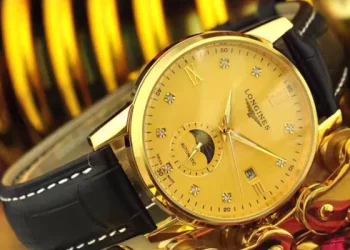A watch movement, also known as a caliber, is the mechanism inside a watch that powers its timekeeping functions. It is the beating heart of the timepiece, responsible for accurately measuring the passage of time. Watch movements can be broadly categorized into two types: quartz and mechanical. In this article, we will explore the different types of watch movements and how they function.
Quartz Movements:
Quartz movements are powered by a battery and use a quartz crystal to regulate the timekeeping function. The battery sends an electric current through the crystal, causing it to vibrate at a specific frequency. The watch’s circuitry measures these vibrations and converts them into a steady pulse, which powers the watch’s hands.
Quartz movements are very accurate and reliable, and they require very little maintenance. They are also relatively inexpensive to produce, making them the most popular type of movement in the market today. They are commonly found in digital watches and many affordable quartz watches.
Mechanical Movements:
Mechanical movements, on the other hand, use a series of gears, springs, and levers to regulate the timekeeping function. They can be further divided into two sub-categories: manual and automatic.
Manual movements, also known as hand-wound movements, require the wearer to wind the watch regularly by turning the crown. As the crown is turned, a spring inside the movement is wound up, storing energy that is slowly released over time to power the watch’s timekeeping function. Manual movements require daily winding and regular maintenance to ensure their accuracy.
Automatic movements, also known as self-winding movements, are powered by the movement of the wearer’s wrist. A weighted rotor inside the movement spins freely as the watch is worn, generating energy that is stored in a spring. Automatic movements do not require manual winding, but they do require regular wear to keep the spring fully wound. They also require regular maintenance to ensure their accuracy.
Types of Mechanical Movements:
Mechanical movements can be further classified into various types based on their construction, design, and complexity. Here are some of the most common types:
1. Swiss Lever Escapement Movement: This is the most common type of mechanical movement and is found in many luxury watches. It features a lever that locks and unlocks the escape wheel, regulating the watch’s timekeeping function.
2. Co-Axial Escapement Movement: This is a newer type of mechanical movement that was developed by Omega in the 1990s. It features a co-axial escapement that reduces friction and wear, resulting in greater accuracy and longer service intervals.
3. Tourbillon Movement: This is a complex and expensive type of mechanical movement that was developed in the 18th century. It features a rotating cage that houses the escapement, which compensates for the effects of gravity on the watch’s timekeeping function.
4. Chronograph Movement: This type of mechanical movement features additional subdials that allow the wearer to time events with precision.
5. Moonphase Movement: This type of mechanical movement displays the phases of the moon on the watch’s dial.
In conclusion, there are several types of watch movements, each with its own unique characteristics and features. Quartz movements are the most common and affordable, while mechanical movements offer greater accuracy and complexity. Mechanical movements can be further classified into various types based on their design and construction. Whether you prefer the reliability of quartz or the craftsmanship of mechanical movements, there is a watch movement out there that will suit your needs and preferences.





























